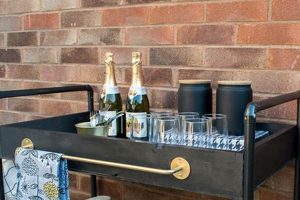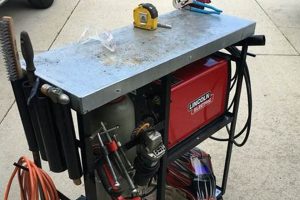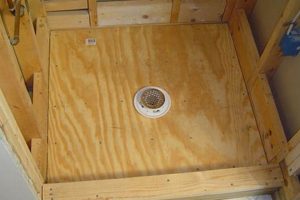A self-constructed outdoor heating feature fueled by natural gas or propane, designed for recreational use, offers a personalized alternative to commercially manufactured fire pits. These custom installations involve assembling components, such as a burner, enclosure, and gas line connections, often according to individual aesthetic preferences and spatial requirements. For example, a homeowner might build a circular fire pit using stone pavers and connect it to an existing propane line for convenient operation.
The appeal of creating one’s own gas-fueled fire feature stems from several factors. Benefits include the ability to tailor the design to specific needs and tastes, potentially resulting in cost savings compared to purchasing a pre-made unit. Furthermore, the process of designing and building it can be a satisfying project for individuals with relevant skills. Historically, the desire to personalize living spaces and engage in hands-on construction has driven many individuals to undertake similar projects.
The subsequent sections will delve into critical considerations for planning and constructing a safe and functional outdoor gas fire feature. Topics covered will include selecting appropriate materials, ensuring proper ventilation, understanding gas line safety protocols, and troubleshooting common issues encountered during installation and operation.
Essential Considerations for DIY Gas Fire Pit Construction
The following guidelines are crucial for a safe and successful construction of a gas-fueled outdoor fire feature. Strict adherence to these points minimizes risks and ensures operational reliability.
Tip 1: Ventilation is Paramount: Adequate airflow surrounding the burner is critical to prevent gas accumulation and potential explosions. Ensure the enclosure incorporates sufficient vents near the base.
Tip 2: Material Selection Matters: Utilize non-combustible materials such as concrete, stone, or metal for the fire pit enclosure. Avoid wood or other flammable materials within close proximity of the burner.
Tip 3: Gas Line Integrity is Non-Negotiable: Employ certified gas fittings and lines suitable for outdoor use. Leak testing with soapy water after each connection is mandatory to confirm a secure seal.
Tip 4: Burner Placement and Support: The burner must be securely mounted and properly positioned within the enclosure. Ensure it is level and protected from direct exposure to wind.
Tip 5: Depth and Diameter Considerations: Determine the appropriate depth and diameter of the fire pit based on the burner size and desired aesthetic. Insufficient depth can lead to inadequate ventilation.
Tip 6: Safety Barrier Implementation: Consider installing a safety barrier, such as a tempered glass wind guard, around the flame to prevent accidental contact and mitigate wind interference.
Tip 7: Local Codes and Regulations: Prior to commencing construction, research and comply with all applicable local building codes and regulations pertaining to gas appliance installations.
In summary, meticulous planning, careful material selection, and strict adherence to safety protocols are essential for the successful and safe operation of a self-constructed gas fire feature. Neglecting these considerations can result in significant safety hazards.
The concluding section will summarize the key aspects of creating a gas fire feature, and provide a final note on safety and responsible use.
1. Ventilation Adequacy
Ventilation adequacy represents a non-negotiable element in the design and construction of a self-built, gas-fueled outdoor fire feature. Its importance stems from the fundamental requirements of combustion and the inherent risks associated with flammable gases.
- Combustion Air Supply
Natural gas or propane requires oxygen for complete and efficient combustion. Insufficient ventilation restricts oxygen supply, leading to incomplete combustion. This results in the production of carbon monoxide, an odorless, colorless, and highly toxic gas. Furthermore, inadequate oxygen can cause the flame to burn inefficiently, producing soot and reducing the overall heat output. The fire pit’s design must incorporate strategically placed vents to allow for continuous air intake, supporting complete combustion.
- Gas Accumulation Prevention
Leaks, while undesirable, can occur in gas line connections. In an enclosed or poorly ventilated space, even a small leak can lead to a buildup of flammable gas. This creates an explosion hazard. Vents near the base of the enclosure facilitate the dispersal of any leaking gas, preventing it from reaching explosive concentrations. The size and placement of these vents are critical and must be calculated based on the enclosure volume and potential leak rate.
- Heat Dissipation
The burning process generates significant heat. While the intention is to radiate heat outwards, the enclosure itself can also become very hot. Proper ventilation assists in dissipating excess heat from the internal structure, preventing overheating of components and reducing the risk of material degradation or failure. Furthermore, it can help moderate the temperature of the outer surfaces, minimizing the risk of burns from accidental contact.
- Pilot Light Stability
Many gas fire pits utilize a pilot light for ignition. The pilot light requires a constant and stable supply of air to remain lit. Insufficient ventilation can cause the pilot light to flicker or extinguish, leading to ignition failures and potentially unsafe situations if unburned gas is released. Therefore, vent placement should consider the pilot light’s location and ensure a consistent flow of air to the burner area.
The correlation between adequate ventilation and a functional outdoor gas fire feature is clear. Neglecting proper airflow introduces significant safety risks and compromises the overall performance of the installation. Therefore, ventilation requirements must be a primary consideration during the planning and construction phases of any self-built gas fire feature project, because this is what made the diy gas fire pit worth it.
2. Material Non-Combustibility
The selection of non-combustible materials constitutes a critical safety parameter in the construction of a self-assembled gas-fueled fire feature. The direct correlation stems from the inherent risk of fire associated with the operation of a gas burner within a confined space. Using combustible materials, such as wood or certain plastics, for the fire pit enclosure creates a significant fire hazard. The intense heat generated by the gas flame can ignite these materials, leading to uncontrolled fires, property damage, and potential injury. For instance, constructing an enclosure using untr
eated wood directly adjacent to the burner would almost certainly result in ignition over time, especially under windy conditions.
The practical significance of understanding and implementing material non-combustibility lies in its preventative effect. Utilizing materials such as concrete, stone, brick, or metal for the construction of the fire pit enclosure eliminates the possibility of the enclosure itself becoming fuel for a fire. These materials can withstand high temperatures without igniting, melting, or significantly degrading. For example, a fire pit constructed from concrete blocks and lined with fire brick provides a robust and fire-resistant barrier between the gas flame and the surrounding environment. Metal components, if used, should be of sufficient thickness to prevent warping or failure due to heat exposure.
In summary, the application of non-combustible materials in the construction of a gas-fueled fire pit is not merely a suggestion but a fundamental safety requirement. Neglecting this aspect introduces unacceptable risks of fire and injury. The careful selection and utilization of appropriate materials directly contribute to the overall safety and longevity of the installation, thus reinforcing the viability of a self-assembled gas fire feature. Addressing material non-combustibility is paramount for a successful and safe project.
3. Gas Line Integrity
Gas line integrity is paramount for any do-it-yourself gas fire pit project. It directly impacts the safety and functionality of the installation, and compromised integrity can lead to hazardous situations involving gas leaks, explosions, and fire.
- Material Compatibility and Ratings
The gas line and associated fittings must be rated for the specific type of gas used (natural gas or propane) and the anticipated pressure. Using incompatible materials can lead to degradation and leaks over time. For example, utilizing a rubber hose not designed for propane can cause it to deteriorate, leading to a dangerous leak. Code compliant materials are essential for a safe installation.
- Proper Connection Techniques
Gas connections require specialized techniques to ensure a leak-proof seal. Threaded connections must be properly cleaned, taped with gas-rated Teflon tape, and tightened to the appropriate torque. Flare fittings must be correctly aligned and tightened to prevent leaks. Improper techniques can result in slow leaks that are difficult to detect initially but pose a long-term hazard. All connections must be tested with soapy water and bubbles must be checked during regular maintenance.
- Leak Detection and Prevention
Regular leak testing is crucial, both during installation and throughout the lifespan of the fire pit. A simple solution of soapy water applied to connections will reveal leaks through the formation of bubbles. Integrating a manual shut-off valve near the fire pit allows for quick isolation of the gas supply in case of emergencies. A gas leak can be deadly and precautions must be taken.
- Protection from Environmental Factors
The gas line must be protected from physical damage and environmental elements such as corrosion and extreme temperatures. Burying the line requires proper depth and backfilling to prevent damage from digging or ground movement. Exposed lines should be shielded from direct sunlight and physical impacts. Without protection, the lifespan of the gas line is greatly reduced.
In summation, ensuring gas line integrity in a DIY gas fire pit project is not merely a recommendation but a necessity. Careful material selection, proper installation techniques, vigilant leak detection, and protection from environmental factors are all vital components of a safe and functional installation. Failure to address these aspects can have severe consequences, highlighting the importance of adhering to best practices and consulting with qualified professionals when necessary.
4. Burner Securement
Burner securement is a fundamental aspect of any self-constructed gas fire feature, playing a critical role in both safety and operational stability. A properly secured burner ensures consistent flame distribution, prevents accidental dislodgement, and minimizes the risk of gas leaks due to compromised connections. The stability afforded by proper securement directly translates to a more reliable and safer experience with the fire pit.
- Mounting Stability and Flame Uniformity
A securely mounted burner maintains its designed position within the fire pit enclosure. This ensures that the flame pattern remains consistent and predictable, preventing uneven heating of the surrounding materials or localized hotspots that could damage the structure. An unstable burner might shift during operation, leading to an asymmetrical flame and potentially directing heat onto unintended surfaces. For example, if a burner is not properly secured and shifts to one side, the fire pit wall on that side could overheat and crack.
- Connection Protection and Leak Prevention
The gas connections to the burner are inherently vulnerable points for leaks. A securely mounted burner minimizes stress on these connections by preventing movement or vibration that could loosen fittings. If the burner is free to move or wobble, the constant strain on the gas lines can eventually lead to leaks, posing a significant safety hazard. Proper securement isolates the connections from these stresses, ensuring the integrity of the gas supply.
- Preventing Accidental Dislodgement
In an outdoor setting, a fire pit is subject to various external factors such as wind, accidental bumps, or even tampering. A securely mounted burner is less likely to be dislodged by these forces. If the burner is easily displaced, it could potentially disconnect from the gas supply, releasing unburnt gas into the environment. Secure mounting helps to mitigate this risk, ensuring the burner remains in place even under adverse conditions. For instance, a gust of wind could easily topple a loosely set burner, but if it’s securely anchored, it remains stable.
- Facilitating Maintenance and Cleaning
A securely mounted burner also simplifies routine maintenance and cleaning. When the burner is firmly in place, cleaning debris or inspecting the gas connections becomes a more straightforward and safer process. A loose or unstable burner makes these tasks more cumbersome and increases the risk of accidentally damaging the gas lines during handling. A securely mounted burner allows for efficient and safe maintenance procedures, contributing to the longevity of the entire fire pit system.
In conclusion, burner securement represents an indispensable step in the construction of a “diy gas fire pit.” By ensuring stability, protecting connections, preventing dislodgement, and facilitating maintenance, proper burner securement directly contributes to the safety, reliability, and longevity of the fire feature. Neglecting this aspect introduces unnecessary risks and compromises the overall quality of the project.
5. Depth Optimization
nter>
Depth optimization, concerning a self-constructed gas fire feature, involves strategically determining the vertical distance between the burner surface and the top edge of the enclosure. This dimension significantly impacts the combustion efficiency, aesthetic appeal, and safety of the appliance. Inadequate or excessive depth can compromise performance and introduce potential hazards.
- Combustion Airflow Dynamics
The depth of the fire pit directly influences the airflow patterns surrounding the burner. Insufficient depth can restrict the supply of oxygen required for complete combustion, leading to the production of carbon monoxide and reducing the overall heat output. Conversely, excessive depth can create a chimney effect, drawing air too rapidly and causing the flame to become unstable or susceptible to being extinguished by wind. For instance, a shallow fire pit may suffocate the flame, while an overly deep one might allow wind to disrupt the burner.
- Heat Radiation and User Comfort
Optimizing the depth ensures efficient heat radiation towards the surrounding area. If the burner is positioned too close to the top edge, the heat may be excessively concentrated, creating discomfort for users seated nearby. Conversely, if the burner is too deep, the enclosure walls may absorb a significant portion of the heat, reducing the amount radiated outwards. A balanced depth provides a comfortable and effective heat distribution, enhancing the user experience. A deeper pit may require users to lean further over the edge, while a too-shallow design can create uncomfortably high temperature.
- Fuel Efficiency and Gas Consumption
Appropriate depth can contribute to optimized fuel efficiency. When the flame is allowed to burn cleanly and efficiently due to proper airflow, less gas is required to achieve the desired heat output. Incorrect depth leading to incomplete combustion results in wasted fuel and increased operational costs. For example, a poorly designed fire pit with insufficient depth may consume significantly more gas to produce the same level of warmth as a well-optimized design.
- Aesthetic Integration and Visual Appeal
The depth of the fire pit contributes to its overall aesthetic appeal and integration with the surrounding landscape. A well-proportioned depth creates a visually balanced and pleasing design. Excessive depth can make the fire pit appear disproportionately large or cumbersome, while insufficient depth may make it seem insignificant. Achieving the right depth complements the surrounding environment and enhances the visual impact of the fire feature. Depending on the materials used, the depth ratio has a large effect on the overall design.
In summary, depth optimization is an important factor in the context of a self-constructed gas fire feature. It is not solely based on aesthetic preferences but is rather a calculated dimension that affects combustion, user comfort, fuel efficiency, and visual harmony. Careful consideration of these factors during the design and construction phases ensures a safe, efficient, and aesthetically pleasing outdoor gas fire feature, emphasizing the importance of thorough planning and execution in such projects.
6. Safety Barrier Implementation
Safety barrier implementation represents a critical component of any self-constructed gas-fueled fire feature. Its integration serves to mitigate potential hazards associated with open flames, elevated temperatures, and accidental contact, thereby enhancing overall user safety and reducing the risk of incidents.
- Prevention of Accidental Contact
The primary function of a safety barrier is to prevent unintended contact with the open flame or hot surfaces of the fire pit. This is particularly crucial in environments where children, pets, or individuals with mobility limitations may be present. Barriers constructed from tempered glass, metal mesh, or similar materials create a physical separation, reducing the likelihood of burns or other injuries. For instance, a tempered glass wind guard not only shields the flame from gusts of wind but also serves as a protective barrier, preventing someone from inadvertently touching the burner during operation.
- Mitigation of Wind Effects
Wind can significantly impact the behavior of an open flame, causing it to flicker erratically, spread beyond the intended area, or even extinguish entirely. Safety barriers, particularly those designed as wind guards, help to stabilize the flame by reducing wind turbulence. This promotes more consistent and efficient combustion, minimizing the risk of sparks or embers being carried away by the wind and potentially igniting nearby flammable materials. The barrier effectively creates a sheltered microclimate around the flame, ensuring safer and more predictable operation.
- Containment of Embers and Debris
While gas fire pits are generally cleaner than wood-burning alternatives, they can still produce small embers or debris, especially if the gas mixture is not optimal or if the burner is not properly maintained. A safety barrier, particularly one with a mesh or solid construction, can help contain these embers and prevent them from escaping the fire pit area. This reduces the risk of fire spreading to surrounding vegetation or structures. The barrier acts as a filter, trapping any stray particles and ensuring they remain within the controlled environment of the fire pit.
- Enhanced Visual Aesthetics and Design Integration
Beyond its functional benefits, a safety barrier can also enhance the visual appeal of the gas fire pit. Barriers constructed from materials like tempered glass or decorative metal can add a touch of elegance and sophistication to the overall design. Integrating the barrier seamlessly into the fire pit’s aesthetic creates a cohesive and visually pleasing outdoor feature. The choice of materials and design should complement the surrounding landscape and architectural style, adding to the ambiance of the outdoor space.
In conclusion, safety barrier implementation is an indispensable aspect of diy gas fire pit construction. By preventing accidental contact, mitigating wind effects, containing embers, and enhancing visual aesthetics, safety barriers contribute significantly to the safe, reliable, and enjoyable operation of a self-built gas fire feature. Prioritizing safety barrier integration demonstrates a commitment to responsible design and construction practices, ensuring a positive experience for all users.
7. Code Compliance
Code compliance represents a foundational requirement in the creation of a “diy gas fire pit,” acting as a non-negotiable safeguard against potential hazards and ensuring adherence to established safety standards. The construction of a gas-fueled appliance, irrespective of its scale, carries inherent risks associated with flammable gases and combustion processes. Building codes are designed to mitigate these risks through specific regulations governing materials, installation procedures, and safety features. Deviation from these codes can result in serious consequences, including gas leaks, fires, explosions, and legal liabilities. Consider the scenario of a homeowner constructing a fire pit without proper permitting or adherence to gas line pressure testing r
equirements; a subsequent gas leak could lead to an explosion, causing property damage and potential injury to inhabitants and neighbors.
The importance of code compliance extends beyond immediate safety concerns to encompass long-term operational reliability and legal protection. Local building codes typically dictate minimum clearances from structures, property lines, and combustible materials. They also specify requirements for gas line sizing, ventilation, and shut-off valve accessibility. Adhering to these regulations ensures that the fire pit operates safely and efficiently for its intended lifespan. Furthermore, compliance with building codes protects the homeowner from potential legal repercussions in the event of an accident or inspection. For instance, if a fire originating from a non-compliant fire pit damages neighboring property, the homeowner could be held liable for damages and subject to fines.
In conclusion, code compliance is not merely a bureaucratic formality but an integral aspect of responsible gas fire pit construction. It is essential to consult local building codes and obtain necessary permits prior to commencing any “diy gas fire pit” project. This proactive approach minimizes risks, ensures adherence to safety standards, and provides legal protection, underscoring the critical link between code compliance and the successful, safe operation of a self-built gas fire feature. Ignoring code compliance can have devastating results.
Frequently Asked Questions
The following section addresses common inquiries regarding the planning, construction, and safe operation of a self-constructed gas-fueled outdoor fire feature. These questions and answers aim to provide clarity and promote responsible practices.
Question 1: Is a permit required for a DIY gas fire pit?
Permit requirements vary significantly depending on local building codes and regulations. Contacting the local building department prior to construction is essential to determine if a permit is necessary. Failure to obtain required permits can result in fines, project delays, or forced removal of the fire pit.
Question 2: What type of gas line is suitable for a DIY gas fire pit?
The gas line must be specifically designed and rated for outdoor use and the type of gas being used (natural gas or propane). Black iron pipe or flexible stainless steel gas lines are commonly employed. Consult with a qualified gas technician to determine the appropriate gas line size and material for the specific installation.
Question 3: How can gas leaks be detected in a DIY gas fire pit?
A solution of soapy water can be applied to all gas connections. The formation of bubbles indicates a leak. Electronic gas leak detectors can also be used for more precise detection. If a gas leak is suspected, immediately shut off the gas supply and contact a qualified gas technician.
Question 4: What materials are safe to use for the fire pit enclosure?
Non-combustible materials such as concrete, stone, brick, or metal must be used for the fire pit enclosure. Avoid using wood or other flammable materials near the burner. Ensure that the materials are capable of withstanding high temperatures without degrading or releasing hazardous fumes.
Question 5: How much ventilation is required for a DIY gas fire pit?
Adequate ventilation is crucial to prevent gas accumulation and ensure proper combustion. The enclosure must incorporate vents near the base to allow for continuous air intake. The size and number of vents will depend on the dimensions of the enclosure and the burner’s BTU rating. Consulting manufacturer specifications is advised.
Question 6: What safety precautions should be taken when operating a DIY gas fire pit?
Never leave the fire pit unattended while in operation. Keep flammable materials away from the flame. Ensure that a fire extinguisher is readily available. Familiarize oneself with the shut-off valve location and operation. Supervise children and pets closely when the fire pit is in use.
The provided answers highlight the critical importance of safety and compliance in any self-constructed gas fire feature project. Consulting with qualified professionals is strongly recommended to ensure a safe and functional installation.
The subsequent section will provide resources for further information and assistance with diy gas fire pit projects.
DIY Gas Fire Pit
This examination has underscored the complexities inherent in constructing a “diy gas fire pit.” From the criticality of code compliance and gas line integrity to the nuances of ventilation and material selection, the creation of such a feature demands a thorough understanding of potential hazards and adherence to established safety protocols. The presented information serves to highlight the multifaceted considerations involved in a safe and functional installation.
Given the potential risks associated with flammable gas and combustion, individuals contemplating a “diy gas fire pit” are strongly advised to prioritize safety above all else. Consulting with qualified professionals, such as licensed gas technicians and structural engineers, is not merely recommended but deemed essential. Proceeding without expert guidance may result in significant hazards, potentially endangering lives and property. Prudence and expertise remain paramount when engaging in this endeavor.







